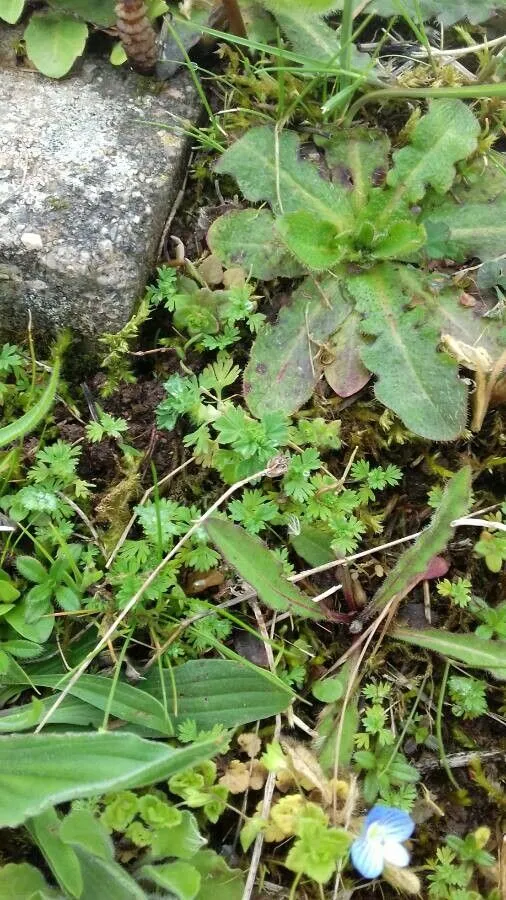
Author: L.
Bibliography: Fl. Carniol., ed. 2, 1: 115 (1771)
Year: 1771
Status: accepted
Rank: species
Genus: Aphanes
Vegetable: False
Observations: Unknown
Field parsley piert, scientifically known as Aphanes arvensis, is a fascinating and often overlooked member of the plant kingdom. Belonging to the Rosaceae family, this small, herbaceous annual plant has garnered interest among botanists and plant enthusiasts alike due to its unique characteristics and adaptability.
First described and documented in 1771 in the second edition of “Flora Carniolica” (Fl. Carniol., ed. 2, 1: 115), field parsley piert owes its nomenclature to the renowned botanist Carl Linnaeus, abbreviated as “L.” in botanical notation. While detailed accounts of its various applications or notable properties are scarce, its documented presence in this comprehensive flora indicates its established role in botanical studies.
Field parsley piert typically features a low-growing habit, often forming dense mats in grasslands, cultivated fields, and disturbed soils. Its finely divided, parsley-like leaves give the plant its common name, while the small, inconspicuous flowers blend seamlessly into its verdant foliage. Despite its unassuming appearance, Aphanes arvensis plays a vital role in the ecosystems it inhabits, contributing to soil health and providing habitat for various small organisms.
Although specific observations regarding this plant’s uses or ecological interactions remain largely undocumented, field parsley piert’s resilience and ubiquity make it a subject of potential interest for further research. Understanding its adaptability, growth patterns, and potential medicinal or ecological benefits could provide valuable insights into sustainable agricultural practices and biodiversity conservation.
In summary, field parsley piert (Aphanes arvensis) is a member of the Rosaceae family with a modest but significant presence in botanical literature. Documented by Carl Linnaeus in 1771, this plant’s understated charm and ecological importance warrant further exploration and appreciation within the scientific community and beyond.
Deu: ackerfrauenmantel, gewöhnlicher acker-frauenmantel, gewöhnlicher ackerfrauenmantel
Dan: almindelig dværgløvefod, dværgløvefod
Eng: common parsley-piert, field parsley piert, parsley-piert, field parsley-piert
Nor: aakerkaase, drivkaase, vesselkaape
Fra: aphane des champs, alchémille des champs, aphanès des champs
Ces: drobnobyl rolná
Nld: grote leeuwenklauw
Fin: peltopoimulehti
Swe: peltopoimulehti, storjungfrukam, jungfrukam
Nob: åkermarikåpe
Nno: åkermarikåpe
Cym: troed y dryw
En: Field parsley piert, Field parsley, Parsley-piert, Common Parsley-piert, Field parsley-piert, Field Lady’s-mantle, Parsley Breakstone, Parsley Piercestone, Parsley Piert
Bg: Полски афанес
Cs: Nepatrnec rolní, Drobnobyl rolná
Da: Almindelig dværgløvefod, Dværgløvefod
Nl: Grote leeuwenklauw, Akker Leeuwenklauw, Akkerleeuweklauw, Grote Leeuweklauw
Et: Harilik põldkortsleht
Fi: Peltopoimukki, Peltopoimulehti
Fr: Aphane des champs, Alchémille des champs, Aphanès des champs, Perce-pierre
De: Acker-Sinau, Ackerfrauenmantel, Gewöhnlicher Ackerfrauenmantel, Gewöhnlicher Acker-Frauenmantel, Acker-Frauenmantel
He: עטייה זעירה
It: Ventaglina dei campi
Lt: Dirvinė mažuolė
Lb: Broochkraut
No: Aakerkaase, Drivkaase, Vesselkaape
Nb: Åkermarikåpe
Nn: Åkermarikåpe
Fa: افانس ارونسیس
Pl: Skrytek polny
Sk: Drobnobyľ roľná
Es: Pie de león
Sv: Jungfrukam, Peltopoimulehti, Storjungfrukam
Cy: Troed y Dryw
Taken Apr 19, 2016 by Tela Botanica − Jean-Paul COROLEUR (cc-by-sa)
Taken Apr 13, 2017 by Yoan MARTIN (cc-by-sa)
Taken Apr 13, 2017 by Yoan MARTIN (cc-by-sa)
Taken Apr 13, 2017 by Yoan MARTIN (cc-by-sa)
Taken Apr 13, 2022 by Tristan Jaton-Maria (cc-by-sa)
Taken Apr 24, 2021 by Mica Mica Tranum (cc-by-sa)
Taken Feb 25, 2021 by Pia Brinkmann (cc-by-sa)
Taken Apr 13, 2022 by Tristan Jaton-Maria (cc-by-sa)
Taken Apr 13, 2022 by Tristan Jaton-Maria (cc-by-sa)
Taken Apr 13, 2022 by Tristan Jaton-Maria (cc-by-sa)
Taken Apr 8, 2014 by Tela Botanica − Jean-Claude ECHARDOUR (cc-by-sa)
Taken May 4, 2022 by jacques maréchal (cc-by-sa)
Taken Apr 3, 2005 by EOL − Steve Matson (cc-by-nc)
Taken May 7, 2010 by Tela Botanica − Mathieu MENAND (cc-by-sa)
Taken May 19, 2020 by Jacques Maréchal (cc-by-sa)
Taken Jun 5, 2013 by Martin Bishop (cc-by-sa)
Taken Dec 7, 2008 by EOL − Keir Morse (cc-by-nc-sa)
Taken Jan 14, 2009 by EOL − Keir Morse (cc-by-nc-sa)
Taken Apr 3, 2005 by EOL − Steve Matson (cc-by-nc)
Taken Jun 5, 2013 by Martin Bishop (cc-by-sa)
Taken Aug 15, 2017 by Photoflora – Benoit BOCK (©)
Taken Jun 14, 2005 by Tela Botanica − Laurent PETIT (cc-by-sa)
Taken May 31, 1853 by Tela Botanica − Herbier PONTARLIER-MARICHAL (cc-by-sa)
Taken Mar 21, 2014 by Tela Botanica − Jean-Claude ECHARDOUR (cc-by-sa)
Taken Mar 21, 2014 by Tela Botanica − Jean-Claude ECHARDOUR (cc-by-sa)
Ph maximum: 5.5
Ph minimum: 5.0
Light: 7
Atmospheric humidity: 3
Soil nutriments: 5
Family: Myrtaceae Author: (F.Muell.) K.D.Hill & L.A.S.Johnson Bibliography: Telopea 6: 402 (1995) Year: 1995 Status:…
Family: Rubiaceae Author: Pierre ex A.Froehner Bibliography: Notizbl. Bot. Gart. Berlin-Dahlem 1: 237 (1897) Year:…
Family: Sapindaceae Author: Koidz. Bibliography: J. Coll. Sci. Imp. Univ. Tokyo 32(1): 38 (1911) Year:…
Family: Asteraceae Author: A.Gray Bibliography: Pacif. Railr. Rep.: 107 (1857) Year: 1857 Status: accepted Rank:…
Family: Fabaceae Author: Medik. Bibliography: Vorles. Churpfälz. Phys.-Ökon. Ges. 2: 398 (1787) Year: 1787 Status:…
Family: Aspleniaceae Author: (Cav.) Alston Bibliography: Bull. Misc. Inform. Kew 1932: 309 (1932) Year: 1932…